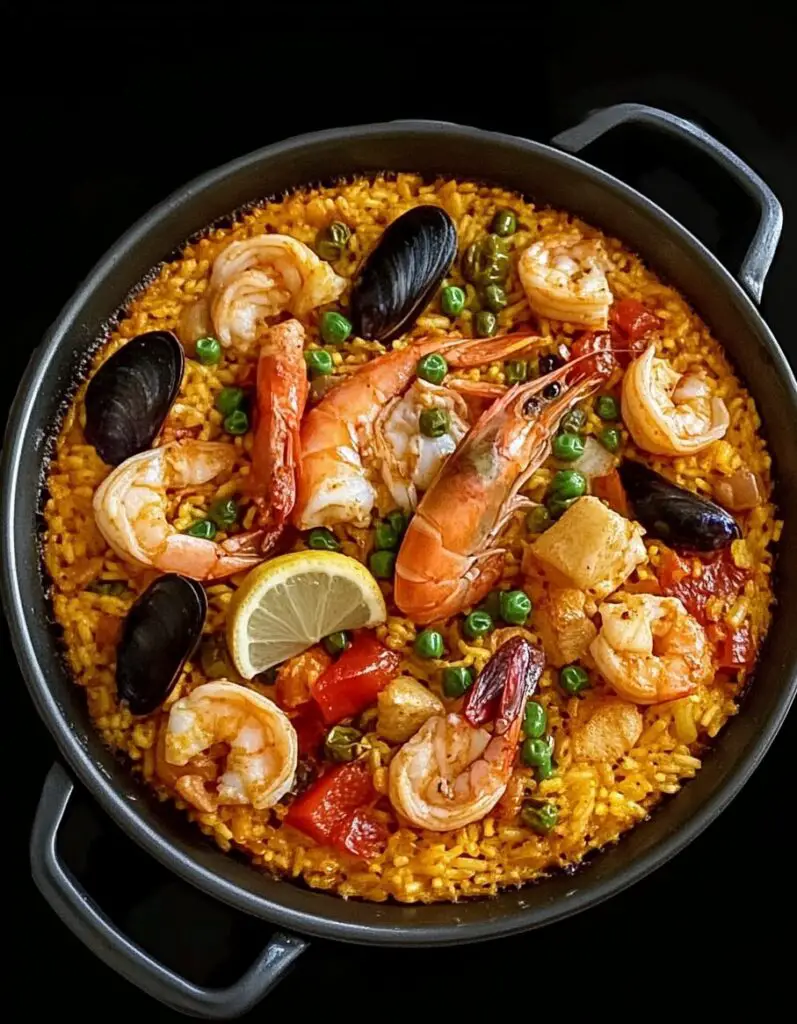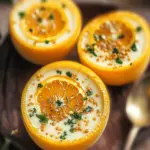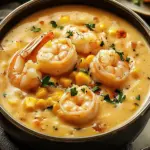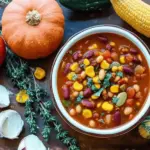Seafood Paella is a vibrant and flavorful Spanish dish packed with shrimp, mussels, calamari, and perfectly seasoned rice. This easy-to-prepare, non-traditional version is ideal for family dinners or special occasions. With its rich flavors and stunning presentation, it’s sure to impress and transport you to the sunny coasts of Spain.
Ingredients
Main Ingredients:
- 500 g (1 lb) prawns/shrimp, peeled and deveined
- 250 g (½ lb) calamari, sliced
- 250 g (½ lb) mussels (half-shell or fresh)
- 1 onion, finely chopped
- 4 garlic cloves, minced
- 400 g (14 oz) chopped tomatoes
- 1 tsp smoked paprika
- 2 cups short-grain rice (Arborio or Bomba preferred)
- 4 cups chicken or fish stock
- 2 tsp salt
- 1 tsp black pepper
- Olive oil for cooking
Garnish:
- Lemon wedges
- Fresh parsley, chopped
Directions
1. Prepare the Seafood:
- Peel and devein the shrimp. Pat the shrimp and calamari dry with paper towels.
- Heat a large skillet or paella pan over medium-high heat. Drizzle seafood with olive oil, season with salt, and sear in the hot pan until lightly golden. Remove and set aside.
2. Start the Paella:
- In the same pan, heat olive oil and sauté the onion and garlic until fragrant and translucent.
- Add the chopped tomatoes and cook until most of the liquid evaporates.
3. Cook the Rice:
- Stir in the smoked paprika and rice. Season with salt and pepper.
- Pour in the stock and bring to a simmer. Cover partially and let cook for 7–10 minutes, or until most of the liquid has been absorbed and the rice is nearly tender.
4. Add the Seafood:
- Nestle the shrimp, calamari, and mussels into the rice. Cover again and cook for another 5–7 minutes, or until the seafood is cooked through and the mussels have opened. Discard any unopened mussels.
5. Serve:
- Garnish with lemon wedges and chopped parsley. Serve hot and enjoy!
Nutrients (Per Serving)
- Calories: 431 kcal
- Protein: 37 g
- Carbohydrates: 59 g
- Fat: 4 g
- Saturated Fat: 1 g
- Sodium: 1707 mg
- Fiber: 2 g
- Sugar: 3 g
- Vitamin A: 323 IU
- Vitamin C: 17 mg
- Calcium: 197 mg
- Iron: 5 mg
Enjoy this hearty and healthy one-pan wonder that brings the essence of Spain to your table!
Exploring the Essence of Seafood Paella: A Spanish Culinary Treasure
Seafood Paella is much more than just a meal—it’s a celebration of Spain’s rich cultural heritage, a dish that embodies the vibrant flavors of the Mediterranean coast. From its humble origins to its global popularity, this dish holds a special place in the hearts of food enthusiasts worldwide. Below, we delve into the background, variations, techniques, and cultural significance of Seafood Paella to give you a comprehensive understanding of this culinary marvel.
The Origins and Evolution of Paella
Paella hails from Valencia, a region in eastern Spain known for its fertile lands and Mediterranean climate. The dish dates back centuries, initially crafted by farmworkers who cooked rice in a flat pan over an open flame, incorporating whatever ingredients were on hand—rabbit, chicken, or beans. Over time, as Valencia’s coastal trade flourished, seafood became a prominent ingredient, resulting in the beloved Seafood Paella.
Traditionally, paella is cooked in a “paellera,” a wide, shallow pan with handles on either side, designed to ensure even cooking and a perfectly crisped rice base, known as “socarrat.” This crust is considered a hallmark of authentic paella, adding depth and texture to the dish.
A Symphony of Flavors and Textures
What sets Seafood Paella apart is its exquisite balance of flavors and textures. The combination of shrimp, mussels, and calamari introduces briny, oceanic notes that harmonize beautifully with the earthiness of rice and the smokiness of paprika. Fresh tomatoes and garlic lend brightness, while chicken or fish stock infuses richness into every grain of rice. Garnished with vibrant parsley and tangy lemon wedges, the dish achieves a visual and gastronomic appeal that captivates all senses.
Each ingredient plays a crucial role, not only in flavor but also in cultural symbolism. For example:
- Seafood: A nod to Spain’s extensive coastline and maritime traditions.
- Rice: A staple crop in Valencia, representing sustenance and community.
- Paprika and Garlic: Essential Spanish spices that enhance depth and warmth.
Techniques That Make the Difference
Though Seafood Paella is relatively simple to prepare, mastering a few key techniques elevates it from good to exceptional:
- Perfecting the Rice: Use short-grain rice varieties like Arborio or Bomba for their ability to absorb flavors while maintaining a firm texture. The rice should be cooked evenly, with a balance of tender grains and a crisp socarrat layer.
- Layering the Flavors: Sear the seafood first to lock in its natural juices, and use the same pan for cooking the aromatics and rice. This layering technique builds depth and cohesion in the dish.
- Timing the Seafood: Overcooking can result in rubbery textures. Adding the seafood toward the end ensures it remains tender and succulent.
- Achieving the Socarrat: Once the rice is nearly cooked, increase the heat slightly to create the coveted crust at the bottom of the pan. Avoid stirring during this stage.
Variations and Adaptability
While the classic Seafood Paella recipe shines as it is, the dish offers room for creativity and personalization. Depending on local ingredients and preferences, you can explore these variations:
- Mixed Paella: Combines seafood with chicken or chorizo for a heartier version.
- Vegetarian Paella: Omits seafood and incorporates seasonal vegetables like bell peppers, artichokes, and green beans.
- Black Paella (Arroz Negro): Features squid ink for a striking black hue and enhanced seafood flavor.
- Shellfish Extravaganza: Focuses exclusively on shellfish like lobster, scallops, and clams.
Each variation showcases the versatility of paella, allowing it to adapt to different culinary contexts and tastes.
The Social and Cultural Dimensions of Paella
Paella is more than just food in Spain—it’s an experience that fosters togetherness. Traditionally served as a communal dish, paella is often enjoyed during family gatherings, festivals, or celebrations. Its preparation becomes a shared activity, with each participant contributing to the process, whether by sourcing fresh ingredients, stirring the pot, or setting the table.
The dish’s vibrant presentation also makes it a showstopper at special occasions. The colorful array of seafood, herbs, and rice arranged in a broad, glistening pan is a feast for the eyes, sparking conversations and admiration.
Beyond Spain, paella has transcended borders to become a global favorite. Its adaptability and universal appeal have earned it a spot on menus worldwide, introducing countless people to the essence of Spanish cuisine.
Nutritional Benefits of Seafood Paella
Seafood Paella is not only a treat for the taste buds but also a nutritious meal packed with health benefits:
- High in Protein: Shrimp, calamari, and mussels are excellent sources of lean protein, supporting muscle growth and repair.
- Rich in Omega-3s: Seafood contributes heart-healthy omega-3 fatty acids, which promote cardiovascular health.
- Low in Fat: The dish relies on olive oil, a healthy fat, for cooking, making it lighter than many other comfort foods.
- Packed with Micronutrients: The inclusion of garlic, tomatoes, and parsley provides essential vitamins and minerals, including vitamin C, vitamin A, iron, and calcium.
For those watching their diet, the dish can be customized by reducing the oil or opting for lower-sodium stock without compromising its flavor.
Conclusion: A Culinary Journey to Spain
Seafood Paella is more than a dish—it’s an invitation to explore the rich culinary and cultural heritage of Spain. Its harmonious blend of seafood, rice, and aromatic spices transports you to the sunny coasts of Valencia, offering a sensory experience like no other. Whether prepared for a casual family dinner or a grand celebration, this dish never fails to impress with its bold flavors and stunning presentation.
By embracing the techniques, variations, and cultural significance of Seafood Paella, you’re not just cooking—you’re participating in a time-honored tradition that brings people together over a shared love for good food. Add a touch of Spanish flair to your next gathering, and watch as this vibrant dish becomes the highlight of your culinary repertoire.







